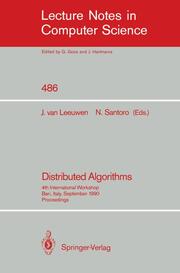Detailansicht
Distributed Algorithms
4th International Workshop, Bari, Italy, September 24-26,1990.Proceedings., Lecture Notes in Computer Science 486
ISBN/EAN: 9783540540991
Umbreit-Nr.: 1483892
Sprache:
Englisch
Umfang: viii, 436 S.
Format in cm:
Einband:
kartoniertes Buch
Erschienen am 19.06.1991
- Zusatztext
- InhaltsangabeSelf-stabilizing ring orientation.- Memory-efficient self stabilizing protocols for general networks.- On the computational power needed to elect a leader.- Spanning tree construction for nameless networks.- A linear fault-tolerant naming algorithm.- Distributed data structures: A complexity-oriented view.- An improved algorithm to detect communication deadlocks in distributed systems.- On the average performance of synchronized programs in distributed networks.- Distributed algorithms for reconstructing MST after topology change.- Efficient distributed algorithms for single-source shortest paths and related problems on plane networks.- Stepwise development of a distributed load balancing algorithm.- Greedy packet scheduling.- Optimal computation of global sensitive functions in fast networks.- Efficient mechanism for fairness and deadlock-avoidance in high-speed networks.- Strong verifiable secret sharing extended abstract.- Weak consistency and pessimistic replica control.- Localized-access protocols for replicated databases.- Weighted voting for operation dependent management of replicated data.- Wakeup under read/write atomicity.- Time and message efficient reliable broadcasts.- Early-stopping distributed bidding and applications.- Fast consensus in networks of bounded degree.- Common knowledge and consistent simultaneous coordination.- Agreement on the group membership in synchronous distributed systems.- Tight bounds on the round complexity of distributed 1-solvable tasks.- A time-randomness tradeoff for communication complexity.- Bounds on the costs of register implementations.- A bounded first-in, first-enabled solution to the l-exclusion problem.
